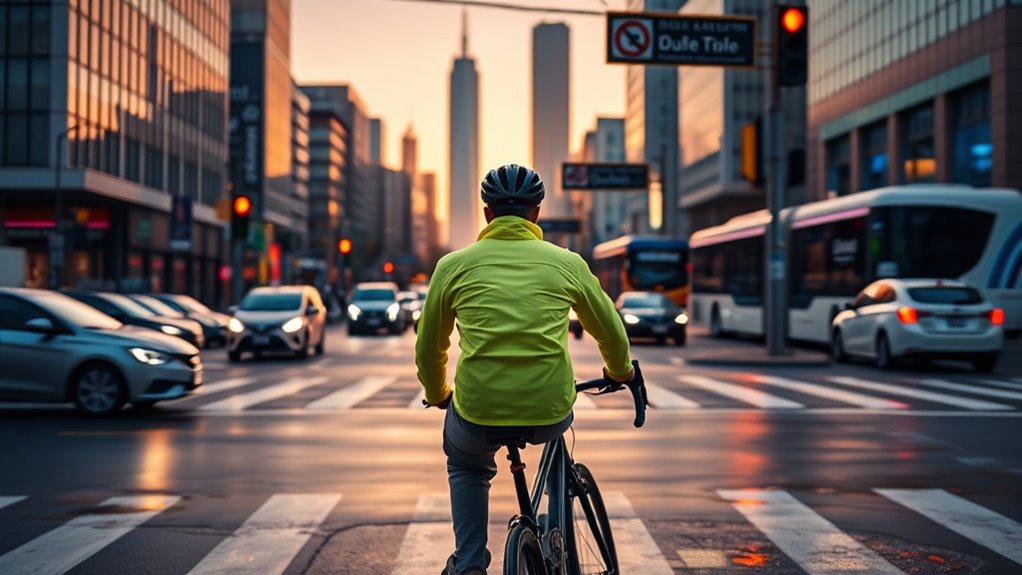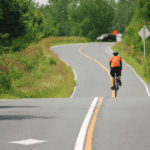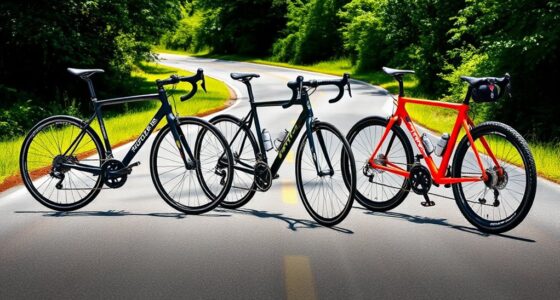When cycling through intersections, stay alert to traffic patterns and signals by watching how vehicles slow, turn, or accelerate. Signal your intentions clearly with hand signals and position yourself in predictable lanes—like the center or right lane for turns. Pay attention to brake lights and turn indicators to anticipate drivers’ actions and make quick decisions. By recognizing these cues, you can navigate safely. Keep going, and you’ll discover more tips to enhance your safety at intersections.
Key Takeaways
- Observe all directions at intersections, including vehicles approaching from front, sides, and behind.
- Recognize traffic patterns like braking, turning signals, and vehicle speed changes to anticipate driver actions.
- Use hand signals early to communicate your intentions clearly to drivers and other cyclists.
- Position yourself predictably in lanes, such as the center for turns or the right for straight, to improve visibility.
- Leverage technology, like AI-enabled devices, for real-time traffic alerts and enhanced safety awareness.

Have you ever wondered how to navigate busy streets safely on your bike? One of the most important skills you can develop is understanding how to read traffic and anticipate what drivers and pedestrians might do next. This starts with building strong intersection awareness. When you approach an intersection, stay alert and look beyond the traffic lights and signs. Observe the movement of cars from all directions—front, sides, and even behind you if possible. Recognize patterns: is that car slowing down or speeding up? Is it signaling a turn or preparing to go straight? By paying close attention to these cues, you can better judge when it’s safe to cross or turn.
Using effective signaling techniques is equally essential. Even though you’re on a bike, signaling your intentions communicates with drivers and pedestrians, reducing confusion and the risk of accidents. When you plan to turn, always use hand signals—extend your arm straight out for a left turn or bend your elbow upward for a right turn. Make these signals clearly and well in advance of the turn, so others have time to react. If you’re stopping, wave your hand or use a brake light if available to indicate your intention to halt. Consistent signaling helps establish your presence in the traffic flow and encourages others to be more predictable around you.
Beyond signaling, your position on the road at intersections matters. Always aim to be visible and predictable. When approaching an intersection, position yourself in the lane where your intentions are clear, typically in the center or slightly to the right, depending on local laws. Avoid weaving between cars or riding too close to parked vehicles, which can obscure your visibility or make you vulnerable to sudden door openings. If you’re planning to turn left, move into the left lane well before the intersection; for right turns, position yourself to the right. This predictable behavior helps drivers understand your intentions and gives them enough time to react. Incorporating on-device AI capabilities can also assist cyclists with real-time traffic alerts and navigation tips, increasing safety.
Frequently Asked Questions
How Can Beginners Improve Their Traffic Reading Skills Quickly?
To improve your traffic reading skills quickly, start paying close attention to traffic signals and road signs. Observe how other cyclists and drivers react to lights and signs, and practice anticipating their actions. Stay alert at intersections, and make a habit of scanning the road ahead. The more you observe and respond to traffic signals and signs, the better you’ll become at reading traffic scenarios confidently and safely.
What Are the Most Common Mistakes Cyclists Make When Reading Traffic?
You often overlook traffic signal awareness and misjudge lane positioning, which can be your biggest mistakes. You might assume drivers see you or that signals don’t matter, risking accidents. Failing to observe signals or position yourself correctly makes it harder to predict drivers’ actions. Always stay alert, watch traffic signals closely, and position yourself confidently in the lane. These habits help you read traffic better and stay safe on your ride.
How Does Weather Affect Traffic Reading for Cyclists?
Weather considerably impacts your traffic reading as rain impacts visibility and road conditions, making it harder to anticipate vehicle movements. Wind influence can push cars or cyclists, altering expected traffic flow. You need to stay extra alert during adverse weather, adjusting your riding based on these factors. Keep a safe distance, slow down if needed, and constantly scan your surroundings to respond effectively to changing weather conditions.
Are There Legal Implications for Misjudging Traffic While Cycling?
Misjudging traffic while cycling can land you in serious legal hot water, with liability risks and potential legal consequences that could feel like a tidal wave. If you’re at fault in an accident, you might face fines, lawsuits, or even criminal charges. Always stay vigilant, read traffic carefully, and follow the law to protect yourself from these risks. Remember, a moment’s mistake could have lifelong legal repercussions.
How Can Cyclists Predict Driver Behavior in Complex Intersections?
You can predict driver behavior in complex intersections by observing driver eye contact and vehicle movement cues. Make eye contact to gauge if the driver has seen you and is aware of your presence. Watch for subtle cues like brake lights, turning signals, or vehicle positioning to anticipate their next move. Staying alert and making eye contact helps you stay proactive, ensuring safer cycling through unpredictable traffic situations.
Conclusion
Mastering traffic reading keeps you safe and swift on your cycle. By spotting signals, scanning surroundings, and staying aware, you stay ahead of hazards and hustle smoothly through busy streets. Remember, being alert isn’t just about avoiding accidents—it’s about asserting control and confidence on your commute. So, stay sharp, scan systematically, and ride responsibly. With focused foresight and fearless focus, you’ll forge forward safely, feeling confident, capable, and in control on every cycling adventure.















